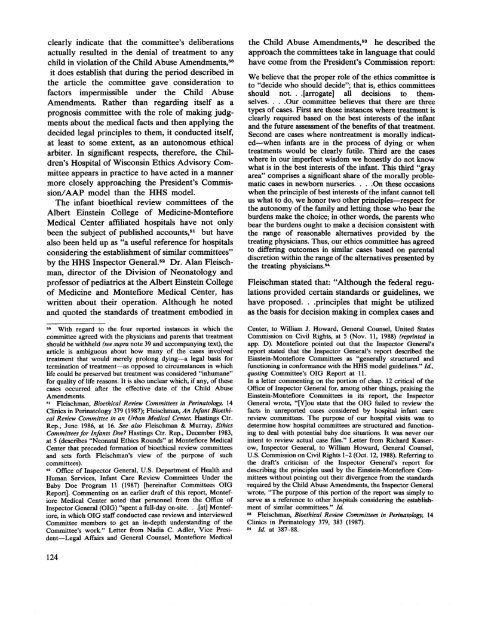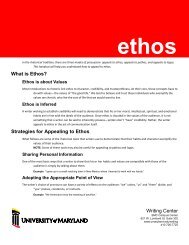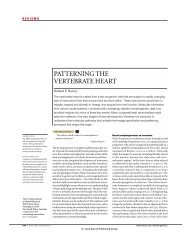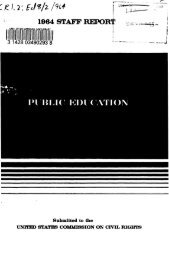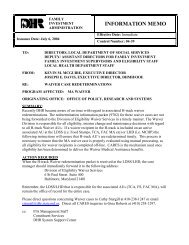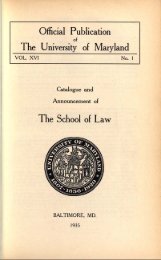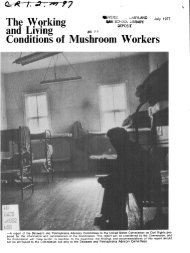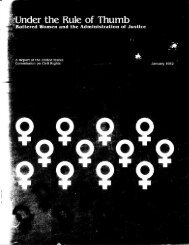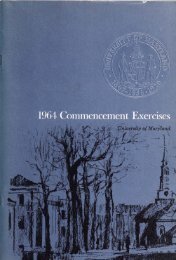clearly indicate that the committee's deliberationsactually resulted in the denial <strong>of</strong> treatment to anychild in violation <strong>of</strong> the Child Abuse Amendments, 50it does establish that during the period described inthe article the committee gave consideration t<strong>of</strong>actors impermissible under the Child AbuseAmendments. Rather than regarding itself as aprognosis committee with the role <strong>of</strong> making judgmentsabout the medical facts and then applying thedecided legal principles to them, it conducted itself,at least to some extent, as an autonomous ethicalarbiter. In significant respects, therefore, the Children'sHospital <strong>of</strong> Wisconsin Ethics Advisory Committeeappears in practice to have acted in a mannermore closely approaching the President's Commission/AAPmodel than the HHS model.The infant bioethical review committees <strong>of</strong> theAlbert Einstein College <strong>of</strong> Medicine-MontefioreMedical Center affiliated hospitals have not onlybeen the subject <strong>of</strong> published accounts, 51 but havealso been held up as "a useful reference for hospitalsconsidering the establishment <strong>of</strong> similar committees"by the HHS Inspector General. 52 Dr. Alan Fleischman,director <strong>of</strong> the Division <strong>of</strong> Neonatology andpr<strong>of</strong>essor <strong>of</strong> pediatrics at the Albert Einstein College<strong>of</strong> Medicine and Montefiore Medical Center, haswritten about their operation. Although he notedand quoted the standards <strong>of</strong> treatment embodied in50With regard to the four reported instances in which thecommittee agreed with the physicians and parents that treatmentshould be withheld (see supra note 39 and accompanying text), thearticle is ambiguous about how many <strong>of</strong> the cases involvedtreatment that would merely prolong dying—a legal basis fortermination <strong>of</strong> treatment—as opposed to circumstances in whichlife could be preserved but treatment was considered "inhumane"for quality <strong>of</strong> life reasons. It is also unclear which, if any, <strong>of</strong> thesecases occurred after the effective date <strong>of</strong> the Child AbuseAmendments.51Fleischman, Bioethical Review Committees in Perinatology, 14Clinics in Perinatology 379 (1987); Fleischman, An Infant BioethicalReview Committee in an Urban Medical Center, Hastings Ctr.Rep., June 1986, at 16. See also Fleischman & Murray, EthicsCommittees for Infants Doe? Hastings Ctr. Rep., December 1983,at 5 (describes "Neonatal Ethics Rounds" at Montefiore MedicalCenter that preceded formation <strong>of</strong> bioethical review committeesand sets forth Fleischman's view <strong>of</strong> the purpose <strong>of</strong> suchcommittees).52Office <strong>of</strong> Inspector General, U.S. Department <strong>of</strong> Health andHuman Services, Infant Care Review Committees Under theBaby Doe Program 11 (1987) [hereinafter Committees OIGReport]. Commenting on an earlier draft <strong>of</strong> this report, MontefioreMedical Center noted that personnel from the Office <strong>of</strong>Inspector General (OIG) "spent a full-day on-site. . .[at] Montefiore,in which OIG staff conducted case reviews and interviewedCommittee members to get an in-depth understanding <strong>of</strong> theCommittee's work." Letter from Nadia C. Adler, Vice President—LegalAffairs and General Counsel, Montefiore Medicalthe Child Abuse Amendments, 53 he described theapproach the committees take in language that couldhave come from the President's Commission report:We believe that the proper role <strong>of</strong> the ethics committee isto "decide who should decide"; that is, ethics committeesshould not. . .[arrogate] all decisions to themselves.. . .Our committee believes that there are threetypes <strong>of</strong> cases. First are those instances where treatment isclearly required based on the best interests <strong>of</strong> the infantand the future assessment <strong>of</strong> the benefits <strong>of</strong> that treatment.Second are cases where nontreatment is morally indicated—wheninfants are in the process <strong>of</strong> dying or whentreatments would be clearly futile. Third are the caseswhere in our imperfect wisdom we honestly do not knowwhat is in the best interests <strong>of</strong> the infant. This third "grayarea" comprises a significant share <strong>of</strong> the morally problematiccases in newborn nurseries. . . .On these occasionswhen the principle <strong>of</strong> best interests <strong>of</strong> the infant cannot tellus what to do, we honor two other principles—respect forthe autonomy <strong>of</strong> the family and letting those who bear theburdens make the choice; in other words, the parents whobear the burdens ought to make a decision consistent withthe range <strong>of</strong> reasonable alternatives provided by thetreating physicians. Thus, our ethics committee has agreedto differing outcomes in similar cases based on parentaldiscretion within the range <strong>of</strong> the alternatives presented bythe treating physicians. 5 *Fleischman stated that: "Although the federal regulationsprovided certain standards or guidelines, wehave proposed. . .principles that might be utilizedas the basis for decision making in complex cases andCenter, to William J. Howard, General Counsel, United StatesCommission on Civil Rights, at 5 (Nov. 11, 1988) (reprinted inapp. D). Montefiore pointed out that the Inspector General'sreport stated that the Inspector General's report described theEinstein-Montefiore Committees as "generally structured andfunctioning in conformance with the HHS model guidelines." Id.,quoting Committee's OIG Report at 11.In a letter commenting on the portion <strong>of</strong> chap. 12 critical <strong>of</strong> theOffice <strong>of</strong> Inspector General for, among other things, praising theEinstein-Montefiore Committees in its report, the InspectorGeneral wrote, "[Y]ou state that the OIG failed to review thefacts in unreported cases considered by hospital infant carereview committees. The purpose <strong>of</strong> our hospital visits was todetermine how hospital committees are structured and functioningto deal with potential baby doe situations. It was never ourintent to review actual case files." Letter from Richard Kusserow,Inspector General, to William Howard, General Counsel,U.S. Commission on Civil Rights 1-2 (Oct. 12, 1988). Referring tothe draft's criticism <strong>of</strong> the Inspector General's report fordescribing the principles used by the Einstein-Montefiore Committeeswithout pointing out their divergence from the standardsrequired by the Child Abuse Amendments, the Inspector Generalwrote, "The purpose <strong>of</strong> this portion <strong>of</strong> the report was simply toserve as a reference to other hospitals considering the establishment<strong>of</strong> similar committees." Id.53Fleischman, Bioethical Review Committees in Perinatology, 14Clinics in Perinatology 379, 383 (1987).54Id. at 387-88.124
have found these principles to be helpful in deliberationsand discussions at our infant bioethical reviewcommittee meetings." 55 Among those principles is:"Withholding or withdrawing treatment may beconsidered when such treatments are reasonablydeemed futile and merely prolonging the dyingprocess or when the medical treatment imposes aburden that lacks compensating benefits for theinfant." 56Commenting on an earlier draft <strong>of</strong> this report,Montefiore Medical Center asserted that these "principlesare intended to assist the Committee membersin applying the Child Abuse Amendments to thecases under review." 57 Emphasizing that the "ChildAbuse Amendments and the regulations thereunderexpressly defer to the 'treating physician's (orphysicians') reasonable medical judgement,'" thecenter stated:In other words, Congress and HHS have made clear thatthe determination as to what, if any, treatment is medicallyindicated, is to be left to the pr<strong>of</strong>essional judgment <strong>of</strong> thetreating physician(s). Given that medical judgments arekey to decision-making under the Child Abuse Amendments,it cannot responsibly be suggested that the Committeehas violated the Child Abuse Amendments, simply onthe superficial observation that medical treatment has beenwithheld. 58The center relied in particular on the HHSinterpretation <strong>of</strong> the exception to a general requirement<strong>of</strong> treatment the Child Abuse Amendmentscreate when "the treatment itself involves significantmedical contraindications and/or significant painand suffering for the infant that clearly outweighsthe very slight potential benefit <strong>of</strong> the treatment foran infant highly unlikely to survive." 59 As thequoted passage makes clear, however, such benefitsburdenbalancing is legal only when the child is» Id. at 384." Id. at 384-85. But cf. 45 C.F.R. § 1340.15(b)(2) (1987)(definition <strong>of</strong> the Federal medical treatment standard <strong>of</strong> carebarring "withholding <strong>of</strong> medically indicated treatment") (discussedin chap. 7).5TLetter from Nadia C. Adler, supra note 52, at 3." Id. at 7-8.S9Id. at 7, quoting 45 C.F.R. §1340.15 app. (1987). See chap. 7.» 42 U.S.C.A. §51O2(2)(B)(3) (West Supp. 1988).81Montefiore Medical Center, commenting on this statement inan earlier draft, expressed concern that it implied the view "thatthe Einstein-Montefiore Committee took a neutral stance and wasattempting to evade responsibility" when in fact the committeemade the referral in order to override the parental refusal toconsent to treatment. Letter from Nadia C. Adler, supra note 52,at 11. The Commission does not mean to suggest that thecommittee's action in this case implied neutrality; rather, in this"highly unlikely to survive." The statutory languageitself requires that "the provision <strong>of</strong> such treatmentwould be virtually futile in terms <strong>of</strong> the survival <strong>of</strong>the infant and the treatment itself under suchcircumstances would be inhumane." 60 Although thelaw is phrased in the conjunctive, the principleFleischman says the Einstein-Montefiore committeesemploy is phrased in the disjunctive: unlike the law,it allows treatment denial in cases <strong>of</strong> futility or underbenefit-burden analysis.From February 1984 through August 1986 (duringthe last 11 months <strong>of</strong> which the Child AbuseAmendments were applicable), eight cases involvingwithholding <strong>of</strong> life-preserving surgery from children"in the first days <strong>of</strong> life" were reviewed by theaffiliated committees. (A total <strong>of</strong> 30 neonatal caseswere reviewed; the article is not clear about thetreatment/nontreatment outcome in the other 22cases.) In one case in which the attending physicianbelieved treatment should be provided and theparents disagreed, the committee referred the matterto the child protective services agency. 61 In asecond case in which the treating physicians andparents believed treatment should be withheld, thecommittee considered that it should be provided,and both the physicians and parents were thenconvinced to agree to continued treatment.In a third case the treating physicians wanted todeny treatment while the parents desired it to beprovided; although the child died (presumably withoutreceiving the life-saving surgery), the committeeretrospectively concluded that "the parents' requestwas imposing undue pain and suffering on the infantfor no potential benefit." In all the other cases thecommittee agreed with the desire <strong>of</strong> physicians andparents to withhold treatment. 62case it is clear that the committee acted properly and fulfilled theresponsibility to report imposed upon it by the law.62Fleischman, supra n. 53, at 388-89. In its letter <strong>of</strong> comment,Montefiore says, concerning the third case: "As Dr. Fleischman'sarticle plainly states, a retrospective review <strong>of</strong> the case (the infantwas imminently dying and indeed died before the Committeecould be convened for prospective review) indicated that theparents' wish to provide treatment would have imposed 'unduepain and suffering on an infant for no potential benefit.' (Fleischman,p. 389) The Report, once again, omits this detail." Letterfrom Nadia C. Adler, supra note 52, at 12. In fact, the Fleischmanarticle at no point states that the child was imminently dying. IfMontefiore is making this assertion based on its review <strong>of</strong> themedical records <strong>of</strong> the case, rather than on the article, then thedenial <strong>of</strong> treatment would in fact not have violated the ChildAbuse Amendments. However, what is striking about the description<strong>of</strong> the case in Fleischman's article, like that <strong>of</strong> all the other125
- Page 1 and 2:
MedicalDiscriminationAgainstChildre
- Page 3 and 4:
idments • Section 504 • Medical
- Page 5:
LETTER OF TRANSMITTALThe PresidentT
- Page 9 and 10:
CONTENTSExecutive Summary 11. Funda
- Page 11:
12. The Performance of the Federal
- Page 14 and 15:
• The role of economic considerat
- Page 16 and 17:
disabilities at the time that the c
- Page 19 and 20:
generated by health care personnel
- Page 21:
ing how they would obtain medical r
- Page 24 and 25:
The Commission sees several advanta
- Page 26 and 27:
acquiescence in the death or elimin
- Page 28 and 29:
Services of the Department of Healt
- Page 30 and 31:
Chapter 1Fundamental Rights: An Int
- Page 32 and 33:
Carlton Johnson was evaluated by a
- Page 34 and 35:
"that Mr. and Mrs. Doe, after havin
- Page 36 and 37:
American Coalition of Citizens with
- Page 38 and 39:
Chapter 2The Physician-Parent Relat
- Page 40 and 41:
In all but a few cases, the parents
- Page 42 and 43:
the family, and the family went alo
- Page 44 and 45:
Chapter 3The Role of Quality of Lif
- Page 47:
transition from education to employ
- Page 50 and 51:
tion programs can become productive
- Page 52 and 53:
unsuccessful efforts of a private a
- Page 54 and 55:
[S]ince I have been at Children's M
- Page 56 and 57:
Another survey by Siperstein, Wolra
- Page 58 and 59:
of life with a child who is disable
- Page 60 and 61:
Chapter 4The Role of Economic Consi
- Page 62 and 63:
©TABLE 4.1Pediatricians' Responses
- Page 64 and 65:
• The differences in average cost
- Page 66 and 67:
FIGURE 4.1Comparative Costs of Inst
- Page 68 and 69:
Chapter 5State LawWhat is the law g
- Page 70 and 71:
Like all authority. . .parental aut
- Page 72 and 73:
This decision, however, was promptl
- Page 74 and 75:
No otherwise qualified handicapped
- Page 76 and 77:
Bloomington's Infant Doe in April 1
- Page 78 and 79:
ONONTABLE 6.1Physician's assessment
- Page 80 and 81:
Essentially, HHS interpreted the su
- Page 82 and 83:
Final 504 RuleHHS received nearly 1
- Page 84 and 85:
lifesaving operations to close her
- Page 86 and 87: any further implementation of the F
- Page 88 and 89: handicapped infants might violate S
- Page 90 and 91: the provision does cover discrimina
- Page 92 and 93: of the infants. The review mechanis
- Page 94 and 95: Under the law, the Department of He
- Page 96 and 97: that "the phrase 'or holds the reas
- Page 98 and 99: allows an infant to be denied nutri
- Page 100 and 101: avoid the explicit standards set fo
- Page 102 and 103: (as opposed to the far) future, the
- Page 104 and 105: It was recognized, therefore, that
- Page 106 and 107: als with the particular disability
- Page 108 and 109: cared for. They are thus different,
- Page 110 and 111: medical advice. Given the magnitude
- Page 112 and 113: tions at all regarding the subject
- Page 114 and 115: strates that there is a grave dange
- Page 116 and 117: Disincentives to Whistle BlowingDen
- Page 118 and 119: Using a cumulative scaling procedur
- Page 120 and 121: Of that 300 we targeted, approximat
- Page 122 and 123: Conclusionphysicians set forth in t
- Page 124 and 125: taking place when a report of suspe
- Page 126 and 127: where the parents say "the child fe
- Page 128 and 129: Nevertheless, the organization oppo
- Page 130 and 131: Chapter 11The Role and Performance
- Page 132 and 133: a member of the American Academy of
- Page 134 and 135: possibilities that "will be most li
- Page 138 and 139: Reviewing the first 30 months of th
- Page 140 and 141: Webster's defines "suspected" as "t
- Page 142 and 143: Chapter 12The Performance of the Fe
- Page 144 and 145: The baby's doctor, E. Laurence Hode
- Page 146 and 147: to achieve a reasonable life". . .w
- Page 148 and 149: an unmarried mother receiving welfa
- Page 150 and 151: can be sure all appropriate actions
- Page 152 and 153: inquiries to determine whether they
- Page 154 and 155: Chapter 13The Protection and Advoca
- Page 156 and 157: authority to conduct retrospective
- Page 158 and 159: facility that uses such a committee
- Page 160 and 161: Chapter 14Findings and Recommendati
- Page 162 and 163: as the coordination and development
- Page 164 and 165: in the advisory process who is conc
- Page 166 and 167: A Dissenting View on the Report Med
- Page 168 and 169: arts) to depend upon knowledge of h
- Page 170 and 171: Attachments to Statement of William
- Page 172 and 173: medical facility. Considerations su
- Page 174 and 175: Fund for the Improvement of Postsec
- Page 176 and 177: eports such as Kopelman et al. demo
- Page 178 and 179: Appendix 1EXPOSING OUR CHILDREN, EX
- Page 180 and 181: abilities or functions, they are de
- Page 182 and 183: My principal reason for objecting t
- Page 184 and 185: I derive this hint from the many co
- Page 186 and 187:
moral distinction. A girl is a huma
- Page 188 and 189:
Appendix 2SURVEY OFSTATE BABY DOE P
- Page 190 and 191:
insure the immediate referral of po
- Page 192 and 193:
Hospital Liaisons Designated in Mos
- Page 194 and 195:
BABY DOE COMPARED WITH REGULAR CPS
- Page 196 and 197:
We also asked state CPS offices wha
- Page 198 and 199:
Limited information was available o
- Page 200 and 201:
one-quarter felt that baby doe case
- Page 202 and 203:
Appendix 3INFANT CARE REVIEW COMMIT
- Page 204 and 205:
and guidelines concerning the withh
- Page 206 and 207:
treated to assure the prompt ^repor
- Page 208 and 209:
3. Educating Staff and FamiliesThre
- Page 210 and 211:
One of the 10 ethics committees vis
- Page 212 and 213:
asphyxiation during the birth proce
- Page 214 and 215:
Prospective Review -- Each committe
- Page 216 and 217:
OBSERVATIONSThe inspection found th
- Page 218 and 219:
May 1, 1989Page 2The Commission adv
- Page 220 and 221:
Doe 1 admitted on the record of the
- Page 222 and 223:
tion is the basis for failure to tr
- Page 224:
her (much appreciated) vote for thi


